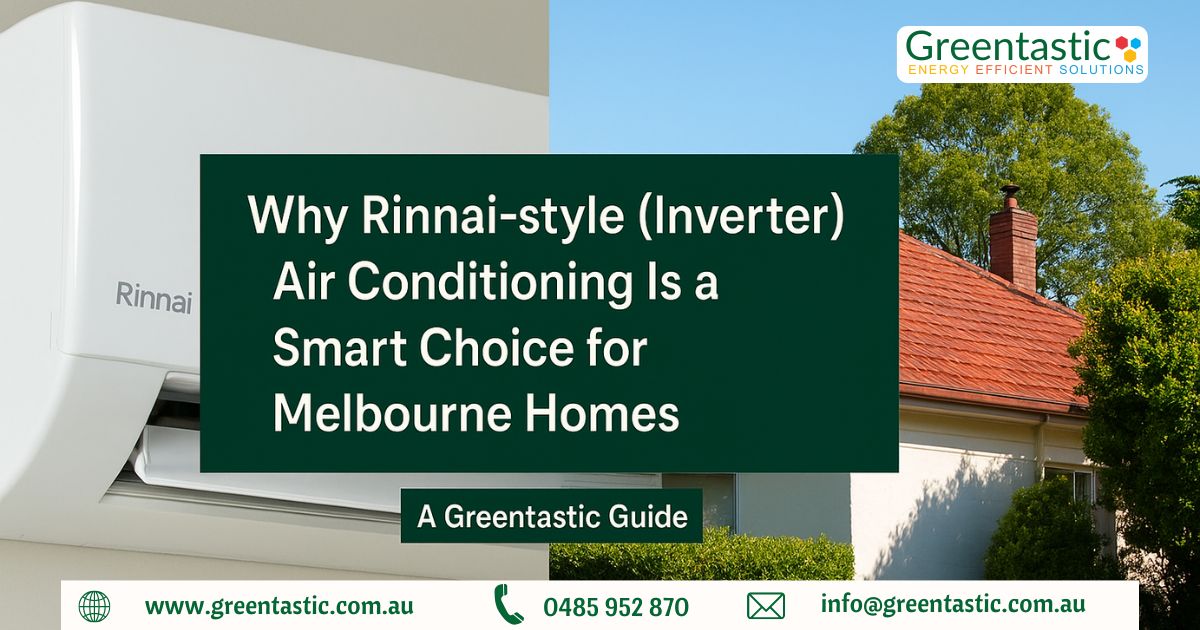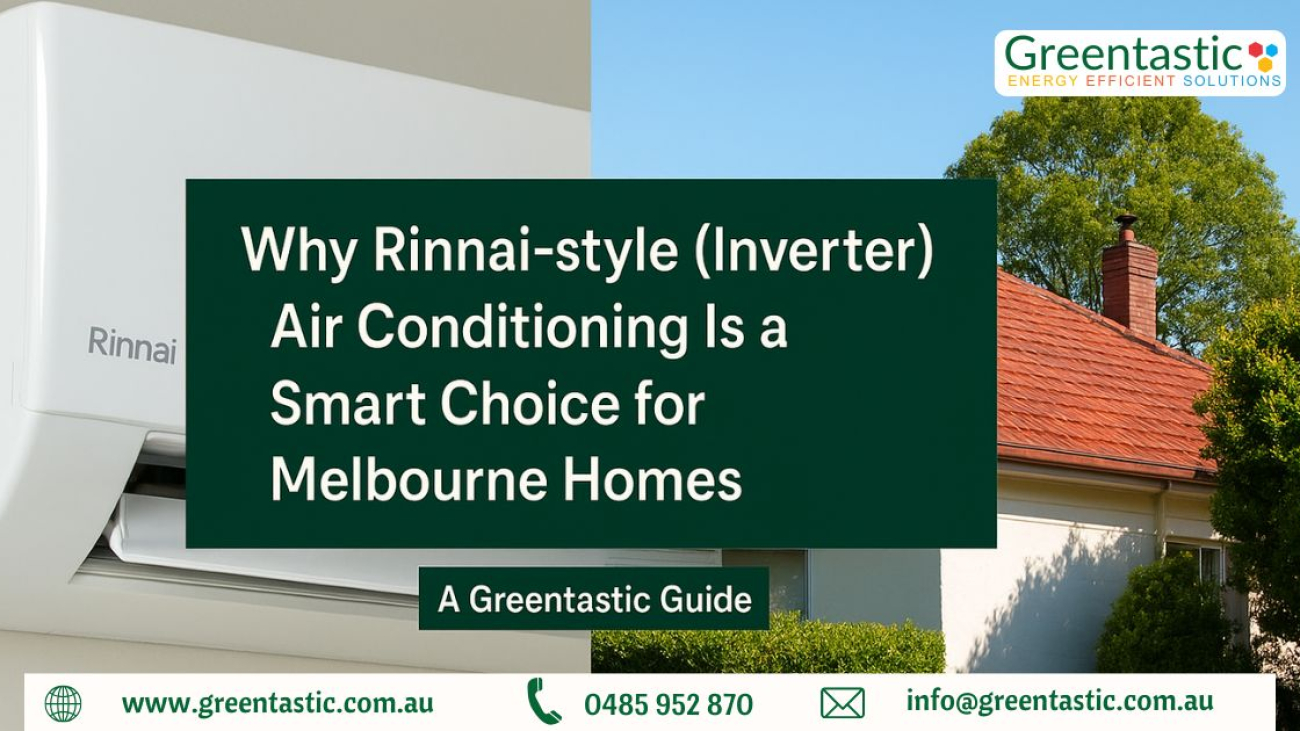
When Melbourne’s seasons flip from chilly mornings to hot afternoons, the right air-conditioning system makes all the difference. High-quality inverter reverse-cycle systems (the type Rinnai and other top brands produce) offer year-round comfort, lower running costs and strong reliability — and when you upgrade you may also qualify for Victoria’s energy rebates. This guide explains the facts, the savings, and why a professional assessment before you buy is essential. Where useful, we’ve linked to authoritative sources so you can check the details.
What makes modern inverter systems (like many Rinnai units) better?
Inverter technology adjusts compressor speed to match demand instead of switching on/off repeatedly. That gives:
- smoother temperature control and less cycling,
- higher seasonal efficiency (lower power use), and
- quieter operation. These advantages are documented in product specs and manufacturer literature for inverter split and ducted ranges.
Many modern Rinnai systems also use R32 refrigerant (lower global warming potential than older refrigerants), have Wi-Fi control and multi-split capability (one outdoor unit running multiple indoor heads), and include features such as zoning or long-distance airflow — useful in multi-room homes.
Rinnai has also extended warranties across a broad range of its air-conditioning range (a recent 7-year warranty roll-out provides extra assurance for homeowners). Always check current warranty terms for the exact models you consider.
Real savings: what Victoria’s government and independent research say
Upgrading an inefficient heater or old air-con can meaningfully reduce running costs. Victoria’s official guidance states that replacing an existing gas space heater with an efficient reverse-cycle air conditioner can reduce operating costs by up to $370 per year, and replacing a ducted gas heater can save up to $1,010 per year (figures are averages and depend on your house and usage).
Independent analysis also supports larger savings in some situations: research summarised by CSIRO and by Renew/IEEFA indicates that households switching fully from gas to efficient electric heat pumps (reverse-cycle systems and heat pumps) can see much larger annual savings in many circumstances — often hundreds to over a thousand dollars per year depending on energy prices and the appliances replaced. Use these figures as indicative; your exact saving depends on fuel prices, system sizing and household use.
Rebates & incentives: the Victorian Energy Upgrades (VEU) program
Victorians can access discounts through the VEU program when they replace old heating/cooling systems with energy-efficient alternatives. The scheme lists eligible products and sets the rebate/discount amounts depending on what you replace and the new system’s efficiency. To qualify you must use an accredited provider and install VEU-approved products. The VEU program is actively updated; check the product register and accredited provider lists before proceeding.
In short: the rebate reduces your upfront cost, and when combined with lower running costs, upgrading often pays back faster than many homeowners expect. (Exact rebate amounts depend on product type, size and what you replace.)
Why a professional assessment matters (don’t skip this step)
A proper assessment is not a sales trick — it’s the difference between a system that works well and one that wastes energy or fails early. Key reasons:
- Correct sizing (Manual J / load calculation):
Accurate load calculations (often using Manual J or equivalent methods) consider insulation, windows, orientation, ceiling height and more. Correct sizing avoids short-cycling (too small) or wasted energy and noise (too large). Accredited installers use these calculations to select the right capacity. - Ducting & layout checks (for ducted systems):
If your home has existing ductwork, the assessor inspects seals, insulation and airflow. Leaky or poorly sized ducts can negate the efficiency gains of a new unit. Proper duct design and sealing matter. (Industry guidance emphasises duct integrity for efficient ducted systems.) - Rebate eligibility & paperwork:
Accredited providers know which products are on the VEU register, how rebates are calculated, and what documentation is needed. That protects your rebate and avoids later compliance issues. - Transparent, comparable quotes:
An assessment produces a clear scope and specification so you can compare quotes fairly — same system size, same duct changes, same warranty inclusions. This reduces hidden costs and surprises.
What to look for when choosing a system (and a supplier)
- Energy rating / star label: choose systems with higher energy-star ratings (higher SEER/COP ratings equal better seasonal performance). Australia’s official energy-rating program explains how stars translate to efficiency. energy.gov.au
- Inverter compressor & variable speed: delivers better seasonal performance vs fixed-speed units.
- Low-GWP refrigerant (R32): better for the climate and increasingly common in modern units.
- Good warranty & local support: longer warranty and local parts/service network reduce long-term cost and downtime. Confirm terms with the manufacturer.
- VEU product listing & accredited installer: if you want the rebate, make sure both product and installer meet VEU requirements. veu-registry.vic.gov.au
Quick case: replacing an old gas space heater
Victorian government guidance shows realistic operating-cost reductions when homeowners replace old gas space heaters with efficient reverse-cycle systems — and in many cases the combined effect of rebates + reduced running costs can make upgrades financially attractive in a relatively short period. For households with older ducted gas heating, the potential operating cost reduction is higher. Always ask your assessor for a tailored savings estimate. Energy
How Greentastic helps (the end-to-end process)
At Greentastic, we:
- perform a free site assessment (load calculation, duct checks, usability review),
- recommend the right inverter split/multi-split or ducted systems that match your home and budget,
- verify VEU product eligibility and help process rebate documentation, and
- provide professional installation, commissioning and after-sales support (including warranty assistance).
If you’re considering an upgrade, book an assessment so you get a transparent quote and a clear estimate of rebate value and likely running-cost savings. (Contact: https://greentastic.com.au/contact/.)
Final takeaway
Upgrading an inefficient heating or cooling system is about more than comfort — it’s a practical path to lower energy bills, better home performance and a smaller carbon footprint. Modern inverter reverse-cycle systems (such as those from Rinnai and other reputable manufacturers) combine efficiency, quiet operation and smart controls. When combined with a VEU-eligible upgrade and a professional assessment, the benefits are real and measurable.
If you want a tailored, evidence-based recommendation for your home, Greentastic can run the assessment, confirm rebates, and install the right system for peak performance. Book a free assessment and claim the savings with confidence.


Leave A Comment